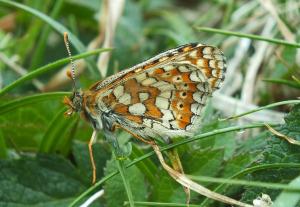
The Marsh Fritillary, a protected butterfly species in the UK (photo: Amanda Scott)
I am one of the kinds of people that I get really annoyed by.
Well, there’s an admission. Let’s narrow it down a bit. In the world of nature conservation, one of the most important, but often unsung, activities is recording what you see. And then, even more importantly, sending in those records somewhere central. Somewhere that other people, people who are just as concerned about wildlife as you are, can use and act on them. And I, up to now, have not been one of the country’s best recorders, to put it mildly. Hence, my annoyance with…me.
Quite frankly, I get a bit bored by recording. Writing it down, sending it in – it’s so much more fun just being out in nature enjoying everything. It’s a chore to take notes and tell other people about what I’ve seen.
Well, that’s what I used to think. But I am now a convert to recording and to sharing my sightings. Here’s why.
Number one. A record of a sighting that is not shared is no use whatsoever. And yes, I mean that, no use at all. OK, it may have been thrilling that I found a new site for a particular declining species of insect, and I may feel protective of that site for very good reasons, but if I don’t send that sighting to the relevant people what might happen? (NB. the ‘I’ is rhetorical here – I may be not very good at recording, but I’m not that bad!).
Well, firstly, if the site in question is put up for development in the future, the appointed ecological consultant will ask for records from the local biological records center which will, of course, have no records of the population of the declining species because the person who found them has failed to submit them. The worst case scenario is that development plans for the site will take no account of what might be important populations of a particular threatened species. That will be, and I’m not mincing my words here, at least partly the fault of the person(s) who failed to record what they’d found. Secondly, any national or local scientific surveys of how a particular species is doing will be incomplete, and that may lead to imperfect or even doomed decisions on future landscape-scale management for that species.
Number two. In these days of intensive farming and lower biodiversity we need to record not only rarer species but, in fact, any species. Today’s common species are tomorrow’s rarities. Go back 50 years and skylarks were abundant. Now, they’re not. If we weren’t recording skylark numbers we’d have no idea of how far they’d declined but, thanks to the BTO’s and RSPB’s excellent recording schemes we can calculate what’s happening. It’s depressing, but at least we know what we’re dealing with.
It’s actually not that hard to record. There are apps, there are simple forms and email addresses. No-one is expected to record everything. Just record the groups of species in which you are interested. Every bit of effort helps. If every single person – man, woman, boy and girl – in the UK was to send in just one or two records a year each, I bet that would significantly increase the number of species records overall.
I am going to make two recording-related commitments for the rest of 2015. Firstly, I will record all species of butterfly (common or rare, adults or caterpillars) that I see and send them to the County Butterfly Recorder. Secondly, given my wildlife garden is in its second year, I will record any wildlife I see there, in my own backyard, and send it to the local records center. I now have a notebook allocated specifically, with a few records already pencilled in (nothing extraordinary, but common species, as I say, are important to record, too).
At least this means I know my records will be contributing to everyone’s understanding of biodiversity, both nationally and locally, in my own patch in Cornwall.
Here are a few links:
Biological Records Centre for Cornwall
Environmental Records Centre for Cornwall and the Isles of Scilly (ERCCIS): http://www.erccis.org.uk/wildlife_recording
Lepidoptera
Butterfly recording in Cornwall (including County Recorder): http://www.cornwall-butterfly-conservation.org.uk/recording.html (records are shared with ERCCIS)
Moth recording in Cornwall: http://www.cornwallmothgroup.org.uk/record.php
Butterfly Conservation: http://butterfly-conservation.org/110/recording-and-monitoring.html (see iRecord Butterflies – a free app)
…and I could list all the ways of recording for various species in Cornwall, but there are various different ones, which is, I guess, what might put some people off. So, if in any doubt, always send to the ERCCIS address above. They share their records with other interested groups in Cornwall, so you know your results will count.
Rare species, common species, all species. We need to know how they’re doing. Keep those records rolling in.

